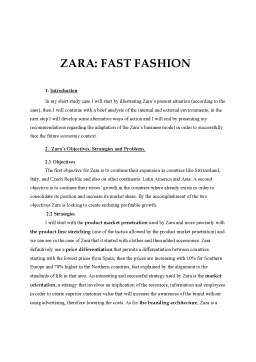Extras din referat
1. Introduction
In my short study case I will start by illustrating Zara’s present situation (according to the case), then I will continue with a brief analysis of the internal and external environments; in the next step I will develop some alternative ways of action and I will end by presenting my recommendations regarding the adaptation of the Zara’s business model in order to successfully face the future economic context.
2. Zara’s Objectives, Strategies and Problems.
2.1 Objectives
The first objective for Zara is to continue their expansion in countries like Switzerland, Italy, and Czech Republic and also on other continents: Latin America and Asia. A second objective is to continue their stores’ growth in the countries where already exists in order to consolidate its position and increase its market share. By the accomplishment of the two objectives Zara is looking to create enduring profitable growth.
2.2 Strategies
I will start with the product market penetration used by Zara and more precisely with the product line stretching (one of the tactics allowed by the product market penetration) and we can see in the case of Zara that it started with clothes and then added accessories. Zara definitively use a price differentiation that permits a differentiation between countries: starting with the lowest prices from Spain, then the prices are increasing with 10% for Southern Europe and 70% higher in the Northern countries, fact explained by the alignment to the standards of life in that area. An interesting and successful strategy used by Zara is the market orientation, a strategy that involves an implication of the resources, information and employees in order to create superior customer value that will increase the awareness of the brand without using advertising, therefore lowering the costs. As for the branding architecture, Zara is a house brand having tree collections categories, each of them personalized: Women (Zara Women, Zara Basics, Trafaluc), Men (Men’s line, Zara Basics, 100 Zara, Zara Sport) and Children Wear.
2.3 Problems
The main problem for Zara is that once with the global expansion the company is getting more and more difficult to coordinate the activities between the headquarter from Spain and the stores from other continents. In U.S Zara didn’t succeed to develop a strong supply chain and this will affect their sales being not able to provide the same services that provide in Europe: distribution facility and strong production. Therefore the vertical integration which is a distinctive feature of their business model tends to affect the costs but in a negative way.
3. Zara’s internal and external environments
3.1 Internal Environment
Zara has several specific capabilities that allow the company to have a solid competitive advantage:
- The ability to quickly respond to the market needs has given a distinctive competitive advantage to the company but other companies tried to copy the model but failed. That lead us to another distinctive capability which is a mix between human resources and Zara IT’s, in my opinion this is something very hard to imitate: a strong company culture embraced by employees that are in a continuous learning process (trainings, workshops) matched with simple to use software.
- Time leadership: the production of the collections is done in maximum 3 weeks; this measure makes Zara come much sooner on the market with new collections than the normal average retailer which needs around 9 months to present a new collection on the market.
- A Global Brand: Zara is beneficiating of a worldwide recognition that was achieved by a innovative design and a constant quality that must provide the stimuli needed in order to create a similar brand meaning for the customers all over the world.
- Differentiation: Zara has a creative design team who give differentiation.
- Cost leadership (which is also a strategy pursued by the company): Zara manufactures 60% of its own products. By owning its in-house production, Zara is able to be flexible in the variety, amount, and frequency of the new styles they produce. Also, 50% of the production is done on client demand, which allows the chain to constantly provide its costumer with updated products. The supply chain permits the rotation of the products that aren’t sold in other countries in order to reach one of the main principles adopted by the company: 0 Inventories. Also the new products are tested first in certain stores before they entered full-run production keeping failures rate at 1 %( in comparison with the industry’s typical 10%).
Preview document
Conținut arhivă zip
- Zara.doc

















